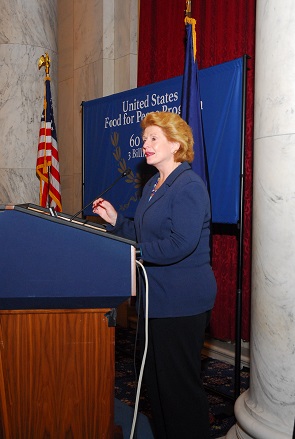WASHINGTON, July 17, 2014 – When President Dwight D. Eisenhower signed Public Law 480 back on July 10, 1954, he was strongly motivated to help farmers deal with mounting surpluses and low prices. Little did he know that, 60 years later, this budding food aid program would be responsible for saving 3 billion lives and building goodwill in 150 countries around the globe.
That was part of the historic perspective shared among a long list of dignitaries attending a Food for Peace celebration in the Kennedy Caucus Room in the Russell Senate office building on Capitol Hill last week. The official program was hosted by Senate Agriculture Committee Chairwoman Debbie Stabenow, D-Mich. and her ranking member, Sen. Thad Cochran, R-Miss.

“It’s been an extraordinary partnership that’s made a huge difference in fighting hunger,” emphasized Stabenow. “With every shipment, we promote American goodwill around the world,”
She also emphasized the bipartisan nature of the partnership behind Food for Peace, ”a bipartisan partnership, and we don't have enough of those these days.”
During Eisenhower’s tenure, both Republicans and Democrats were focused on helping American farmers who were producing much more than U.S. citizens could consume. One of his fellow Kansans, Cheyenne County Farm Bureau member Peter O’Brien, suggested giving countries devastated by World War II aid in the form of food rather than money. In 1954, Kansas Senator Andy Schoeppel sponsored legislation that became known as Food for Peace.
But President John F. Kennedy is widely credited with making the program more popular and pivoting beyond farm surplus issues to addressing humanitarian needs.
"Food is strength, and food is peace, and food is freedom, and food is a helping to people around the world whose good will and friendship we want,” Kennedy noted in 1961.
Over the past 60 years, the program has grown in size and scope, responding to natural and man-made disasters and displaced persons due to conflict, and addressing chronic hunger in places like Sudan, explained Brady Deaton. The former University of Missouri Chancellor cited the important development role played by the program, including the creation of jobs for the “poorest of the poor” and its ability to increase savings and investment in recipient countries.
Deaton was appointed by President Barack Obama as chairman of the Board for International Food and Agricultural Development (BIFAD) in 2011. The BIFAD advises USAID on the topics of food and agriculture in developing countries.
In 2013, 1.1 million metric tons of food valued at approximately $1.4 billion was sent to 46 different countries. The program also provided $577 million in grants to another 29 countries for local and regional purchase of food commodities.
“The program was as much of a projection of American values as it was a provider of food,” notes USAID Administrator Rajiv Shah.

The Food for Peace program has not been without its critics and both Presidents George W. Bush and Barack Obama have suggested reforms that would allow more cash aid, rather than food aid donations to needy countries. In June, Senators Bob Corker, R-Tenn., and Chris Coons, D-Del., introduced the “Food for Peace Reform Act,” legislation aimed at overhauling the U.S. food aid program.
But during last week’s celebration, the focus was on success stories associated with Food for Peace.

Agriculture Secretary Tom Vilsack touted the partnership between USDA and USAID, noting that “food becomes a way we, as American people, can reach out with a very powerful impact.
“What we spend on foreign assistance is a really, really, really smart part of our budget,” Vilsack added.

However, Vilsack said he lamented the fact that very few Americans “understand and appreciate the value of these programs.” He encouraged farmers, government officials and industry leaders to help share the Food for Peace success story.
“We spend a lot of time talking to each other but not enough time talking to the general public” about the benefits of this program, he said.
#30
For more news, go to: www.Agri-Pulse.com

